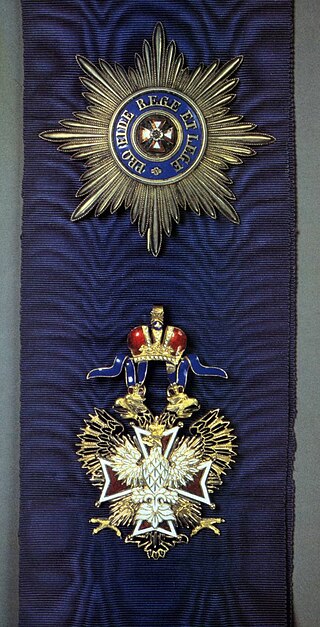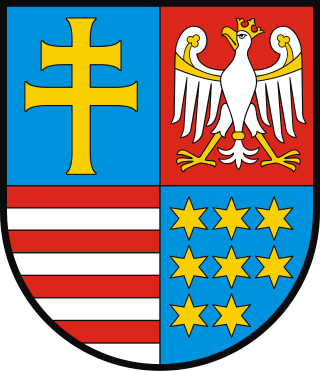
A coat of arms is a heraldic visual design on an escutcheon, surcoat, or tabard. The coat of arms on an escutcheon forms the central element of the full heraldic achievement, which in its whole consists of a shield, supporters, a crest, and a motto. A coat of arms is traditionally unique to the armiger. The term "coat of arms" itself, describing in modern times just the heraldic design, originates from the description of the entire medieval chainmail "surcoat" garment used in combat or preparation for the latter.

The national flag of Poland consists of two horizontal stripes of equal width, the upper one white and the lower one red. The two colours are defined in the Polish constitution as the national colours. A variant of the flag with the national coat of arms in the middle of the white fess is legally reserved for official use abroad and at sea. A similar flag with the addition of a white eagle is used as the naval ensign of Poland.

The coat of arms of Poland is a white, crowned eagle with a golden beak and talons, on a red background.

The Order of the White Eagle is the highest order of merit of the Republic of Poland and one of the oldest distinctions in the world still in use. It was officially instituted on 1 November 1705 by Augustus II the Strong, King of Poland and Elector of Saxony, and bestowed on eight of his closest diplomatic and political supporters. It has since been awarded to the most distinguished Poles for their merits and to the highest-ranking representatives of foreign countries.

The coat of arms of Russia derives from the earlier coat of arms of the Russian Empire. Though modified more than once since the reign of Ivan III (1462–1505), the current coat of arms is directly derived from its medieval original, with the double-headed eagle having Byzantine and earlier antecedents. The general tincture corresponds to the fifteenth-century standard.

Vistula Land, also known as Vistula Country, was the name applied to the lands of Congress Poland from 1867, following the defeats of the November Uprising (1830–1831) and January Uprising (1863–1864) as it was increasingly stripped of autonomy and incorporated into Imperial Russia. It also continued to be formally known as the Kingdom of Poland until the fall of the Russian Empire.[a]

The eagle is used in heraldry as a charge, as a supporter, and as a crest. Heraldic eagles can be found throughout world history like in the Achaemenid Empire or in the present Republic of Indonesia. The European post-classical symbolism of the heraldic eagle is connected with the Roman Empire on one hand, and with Saint John the Evangelist on the other.

The double-headed eagle is an iconographic symbol originating in the Bronze Age. A heraldic charge, it is used with the concept of an empire. Most modern uses of the emblem are directly or indirectly associated with its use by the late Byzantine Empire, originally a dynastic emblem of the Palaiologoi. It was adopted during the Late Medieval to Early Modern period in the Holy Roman Empire, Albania and in Orthodox principalities, representing an augmentation of the (single-headed) eagle or Aquila associated with the Roman Empire. In a few places, among them the Holy Roman Empire and Russia, the motif was further augmented to create the less prominent triple-headed eagle.

The Order of Saint Stanislaus, also spelled Stanislas, was a Polish order of knighthood founded in 1765 by King Stanisław August Poniatowski of the Polish–Lithuanian Commonwealth. It remained under the Kingdom of Poland between 1765 and 1831. In 1831 it was incorporated under the Russian Empire until the Russian Revolution (1917).

The Kraków złoty - was a currency issued in the independent Free City of Cracow in 1835. It was subdivided into 30 groszy. The coins were minted in the Imperial Mint in Vienna.

The Grand Duchy of Kraków was created after the incorporation of the Free City of Cracow into Austria on November 16, 1846. From 1846 to 1918 the title, Grand Duke of Kraków, was part of the official titulary of the Emperor of Austria.

Throughout most of the history of Poland, the banner of Poland was one of the main symbols of the Polish State, normally reserved for use by the head of state. Although its design changed with time, it was generally a heraldic banner, i.e., one based directly on the national coat of arms: a crowned White Eagle on a red field. The banner should not be confused with the flag of Poland, a white and red horizontal bicolor, officially adopted in 1919.

The Reichsadler is the heraldic eagle, derived from the Roman eagle standard, used by the Holy Roman Emperors and in modern coats of arms of Germany, including those of the Second German Empire (1871–1918), the Weimar Republic (1919–1933) and Nazi Germany (1933–1945).

The Treaty of the Three Black Eagles, or Treaty of Berlin, was a secret treaty signed in September and December 1732 between the Habsburg monarchy, the Russian Empire and Prussia.
A national coat of arms is a symbol which denotes an independent state in the form of a heraldic achievement. While a national flag is usually used by the population at large and is flown outside and on ships, a national coat of arms is normally considered a symbol of the government or the head of state personally and tends to be used in print, on armorial ware, and as a wall decoration in official buildings. The royal arms of a monarchy, which may be identical to the national arms, are sometimes described as arms of dominion or arms of sovereignty.

The Imperial Order of the White Eagle was an Imperial Russian Order based on the Polish honor. Emperor Nicholas I of Russia established the award in 1831 as the Imperial and Royal Order of the White Eagle. A recipient of the Order was granted the title Knight of the Imperial Order of the White Eagle.

The coat of arms that serves as the official symbol of the Masovian Voivodeship, Poland, consists of a red escutcheon, that features a white (silver) eagle, with raised wings, and its head turned left. Its current version had been designed by Andrzej Heidrich, and adopted in 2006.

The coat of arms of the Volyn Oblast in Ukraine shows a silver cross in the red field of the shield. The coat of arms was adopted in 1997.

The coat of arms that serves as the symbol of the Świętokrzyskie Voivodeship, Poland, consists of the Iberian style escutcheon (shield), with square top and rounded base, that is divided in the 2 by 2 chessboard pattern. The top left field features a yellow patriarchal cross. The top right field features a white eagle with yellow crown, beak, legs, stripes on its wings, and a ring on its tail. The bottom left field features eight yellow six-pointed starts, placed in three rows, each with three stars, with the exception of the bottom row, that only had 2 stars, placed to the left.

The coat of arms that serves as the symbol of the Podlaskie Voivodeship, Poland is divided into two horizontal red fields. The top field depicts a white eagle, and a bottom field, a knight in a white (silver) armor, sitting on a white (silver) horse with a blue saddle and shabrack, and yellow (golden) harness, standing on its back hoofs. The knight has a blue shield with a yellow (golden) cross of Lorraine on it, put on his left arm, and hold a sword in his right hand. The current design of the coat of arms was designed by Tadeusz Gajl, and adopted in 2001.

























